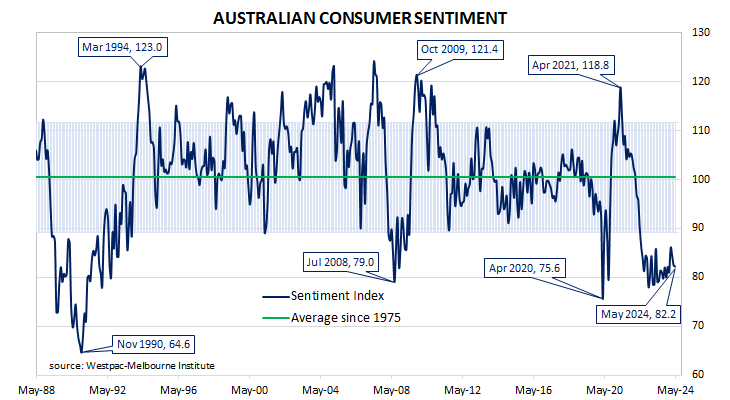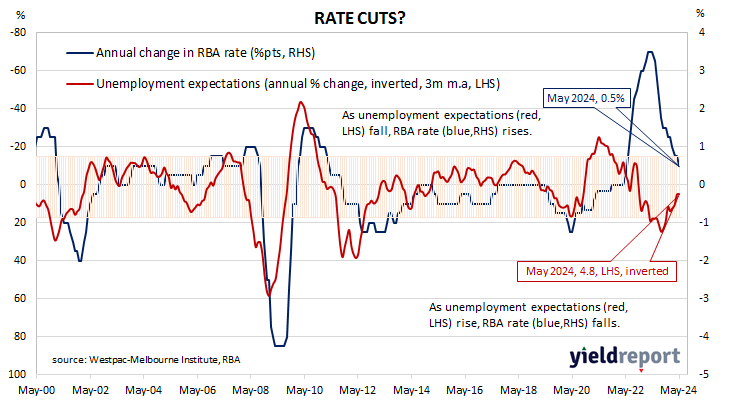Summary: Westpac-Melbourne Institute consumer sentiment index down again in May; cost-of-living pressures, inflation concerns more than offsets relatively well-received Federal Budget; ACGB yields rise modestly; rate-cut expectations soften; expectations improve, overshadowed by deterioration in current conditions, fears of further rate rises; two of five sub-indices lower; more respondents expecting higher jobless rate.
After a lengthy divergence between measures of consumer sentiment and business confidence in Australia which began in 2014, confidence readings of the two sectors converged again in mid-July 2018. Both measures then deteriorated gradually in trend terms, with consumer confidence leading the way. Household sentiment fell off a cliff in April 2020 but, after a few months of to-ing and fro-ing, it then staged a full recovery. However, consumer sentiment has languished at pessimistic levels since mid-2022 while business sentiment has been more robust.
According to the latest Westpac-Melbourne Institute survey conducted over four days in the middle of May, household sentiment remains at a pessimistic level. Their Consumer Sentiment Index declined from April’s reading of 82.4 to 82.2, a reading which is significantly lower than the long-term average reading of just over 101 and well below the “normal” range.
“Renewed cost-of-living pressures and inflation concerns have more than offset what looks to have been a relatively well received Federal Budget,” said Westpac senior economist Matthew Hassan. “Consumer sentiment remains deeply pessimistic.”
Any reading of the Consumer Sentiment Index below 100 indicates the number of consumers who are pessimistic is greater than the number of consumers who are optimistic.
Commonwealth Government bond yields rose modestly along the curve on the day, somewhat in line with overnight movements of US Treasury yields. By the close of business, the 3-year ACGB yield had added 2bps to 3.89%, the 10-year yield had crept up 1bp to 4.26% while the 20-year yield finished 2bps higher at 4.57%.
In the cash futures market, expectations regarding rate cuts in the next twelve months softened. At the end of the day, contracts implied the cash rate would remain close to the current rate for the next few months and average 4.31% through June and 4.33% in August. However, November contracts implied 4.275%, February 2025 contracts implied 4.195% while May 2025 contracts implied 4.055%, 26bps less than the current cash rate.
“While expectations improved a touch in May, this was overshadowed by a further deterioration in current
conditions and fears that persistently high inflation may require further interest rate rises,” added Hassan. ”Importantly, the sentiment level and mix, and responses to additional questions about July’s tax cuts point to continued spending restraint by consumers heading into the second half of the year.”
Two of the five sub-indices registered lower readings, with the “Family finances versus a year ago” sub-index posting the largest monthly percentage loss.
The Unemployment Expectations index, formerly a useful guide to RBA rate changes, increased from 124.6 to 129.8, just over the long-term average. Higher readings result from more respondents expecting a higher unemployment rate in the year ahead.



